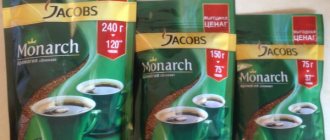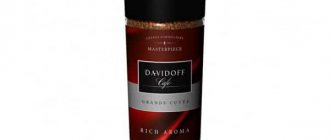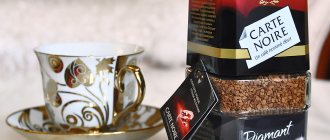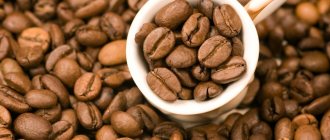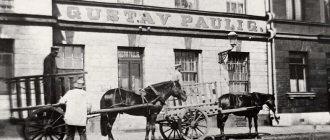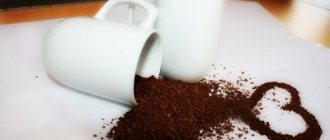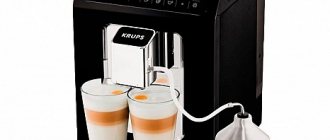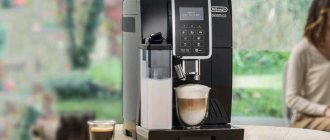The Nescafe brand is a leader in the production of instant coffee. This brand has earned the people's calling and is extremely popular. The range of products is constantly expanding. There are a huge number of types of Nescafe coffee. Each variety has a number of characteristic features, advantages and disadvantages.
Production of instant coffee
Instant coffee is made from Robusta beans.
This variety is famous for the fact that it grows everywhere, is unpretentious and therefore less expensive than the famous Arabica. By the way, it is Robust that contains more caffeine. This is the reason that instant coffee of any brand is stronger than a drink made from ground roasted beans. The raw materials for production, that is, coffee beans, peeled and roasted, are ground. Moreover, the particles of the raw material must be very small so that during subsequent cooking, or rather, processing with hot water under pressure, they release a maximum of extractive substances.
The drink takes a very long time to brew. The process takes about four hours, after which the coffee is cooled and filtered to produce a thick, smooth extract. It is dried hot and the resulting fine powder is obtained. This is the same powdered instant coffee, which is the cheapest of all.
Instant granulated coffee is produced in almost the same way, but at the final stage the powder is treated with hot steam, which causes the grains to stick together.
The granules look much more attractive, do not stick to the spoon and are therefore more popular with consumers.
Otherwise, the process of creating freeze-dried instant coffee occurs, which seems to be an almost natural product. The ground raw materials are treated with boiling water for several hours and the resulting filtered broth is frozen and then dried in a vacuum. The water evaporates and uneven granules are obtained.
Freeze-dried coffee is much more expensive than powdered and granulated coffee, since freezing does not lose the remaining nutrients that were preserved during the brewing of the raw materials.
For people for whom caffeine is contraindicated, decaffeinated instant coffee is available. During the production process, the finished powder is treated with carbonic acid, which is quite harmful to human health, and the level of caffeine in coffee is reduced.
But the myth that such a drink is absolutely free of caffeine remains a myth - the active substance is contained in coffee, albeit in small quantities.
Claimed characteristics of grains
Advertising for all types of Nescafe brand coffee states that only natural beans are used in the production process - Arabica and Robusta. Perhaps the manufacturer means products that go to the Swiss domestic market.
Video: The whole truth about 3 in 1 coffee
According to the current legislation of the country, food products should not contain more than a certain amount of chemical additives. Each batch is checked by independent experts. People in developed countries will also not remain silent if they suspect deception.
Why can't only natural grains be used:
After processing, the bulk of the grain - the grounds - is thrown away or used for technical purposes. All that remains is light extraction (this is done using the correct technology). As much product as Nescafe sells around the world cannot be produced from the grains that are grown. But there is also grain, ground types, blends - there are also a lot of them.
Natural products spoil quickly - the shelf life of Nescafe is 24 months. Specialized stores do not recommend buying tea leaves for more than a week. Only chemistry can retain a scent for a long time, and yet scent is the main focus of advertising.
The fact that Japan supplies beans for Nescafe gives us the right to doubt the rest of the manufacturer’s statements.
Coffee Nescafe Classic
Hello everyone who stopped by!
My review today will contain a lot of sadness and disappointment. Everything good ever goes away, ends and becomes not very pleasant. I remember my love for the NESCAFE brand and it rarely let me down, but lately I have increasingly preferred another. I cheated on her and that’s it. So, there is something for it. Once again I tried to remember what classic Nescafe is and that’s it... My memories have fallen into a deep hole and can’t get out of there, they crawl, rise, try to climb up, but alas... Which is what I’ll talk about later.
Where to buy: yes, in any grocery store and no problem, you don’t even have to look for it, just go in, see, take it.
How much does it cost: in glass version (I like it best) for 95 grams - 150-190 rubles. If you want to save money, they are available in zip bags and are cheaper. According to the promotion, you can buy it in glass for 120-140 rubles, and in soft packaging, I even once took a 250 gram one for only 160 rubles. Most often, look for special offers in Lenta, Magnit, Pyaterochka.
I love coffee in the morning and cannot do without it. I want to cook it quickly and therefore I prefer instant.
How to point and some other information can be found on the can, it can be very useful and worth paying attention to. Most often I take freeze-dried coffee, but classic NESCAFE always comes granulated, so look and know
Most often I take freeze-dried coffee, but classic NESCAFE always comes granulated, so look and know.
No matter how much I take it, it always seems to me that the quality and taste depend on the batch. Lately I've just been unlucky and my hand is no longer reaching out to him. It's too disappointing from purchase to purchase.
Why is he so salty and annoying to me that I’m just picky? I drink basically any coffee and can even try the cheapest one.
I have tried NESCAFE Classic many times already and I was always surprised by the slightly burnt smell when I opened the jar. This aroma almost invariably came from there. Well, oh well, you have to try.
I used to take this coffee to quickly cheer myself up, and it does this perfectly. I liked it for its strength, and the drink was truly one of the strongest I have ever come across.
But lately I can’t drink it, because... When brewed, it turns out to be such a bitter mess with an incredibly burnt aftertaste that you can’t even take much of it into your mouth.
Here, even if you drink and chew quickly, not a single tasty treat can save him. But you definitely can’t deny him cheerfulness.
Coffee dissolves quickly and remember, do not pour boiling water over it. After drinking a cup of hot drink, I didn’t notice any foreign inclusions or sediment at the bottom.
If you add milk, the burnt taste does not disappear and does not go away, it is only masked a little. This taste will haunt you, cause heartburn and will not bring you any pleasure.
Even from one teaspoon it looks very strong and rich, and even more so in taste. Freshly brewed, it just beckons you to try it and exudes a good aroma, but even the smell contains some burntness. I became more and more disappointed with this coffee from purchase to purchase.
I was full of doubts. What happened to classic Nescafe coffee? And year after year the quality only upset me, and lately I don’t even want to take it. Maybe someday I'll give him another chance.
In the meantime, I don’t recommend it to anyone, but before I even liked it, although it was imperfect, but now it’s impossible to drink.
Thank you all for your attention to the review!
Calorie content of coffee with additives
It is rare to find lovers of black coffee without additives: milk, cream, sugar, spices - all this gives the drink new dimensions of taste and aroma, and at the same time - calories.
Milk and cream
Cream perfectly softens the taste of coffee, but significantly increases the number of calories. Usually about 30 ml of milk or cream is added to a cup of black drink. If milk has a fat content of 2.5%, it will add another 16 kcal to coffee; if it is fattier, 3.2% will add 18 kcal. The cream is twice as fat, i.e. will complement the calorie content of coffee by approximately 36 kcal.
Sugar
Sugar greatly increases the calorie content of the drink, a teaspoon of sugar has 24 Kcal, respectively, adding two tablespoons of sugar, we get 48 Kcal. A teaspoon or stick bag with sugar contains about 5 grams of weight, which means that one such serving will make the drink more caloric by 20 kcal, and since one spoon is often not enough, this figure increases by 2 or even 3 times.
Condensed milk
Condensed milk is perfect for coffee, as it not only softens its taste, but also makes it sweet and, accordingly, more caloric. This delicacy has an energy value of 320 kcal per 100 g, therefore, two teaspoons of condensed milk will add another 64 kcal to coffee.
Cognac
Cognac will enrich the taste of coffee and add additional calories to it. Noble alcohol reveals the taste of even the most inexpensive coffee in a special way. However, taking into account that preparing proper coffee with cognac requires about 30 ml of the drink, and its energy value is 239 kcal/100 ml, this results in an increase of 69 kcal per serving.
Liquor
Lovers of coffee with liqueur understand that a tasty additive can cause extra pounds. A sophisticated drink based on berries and spices will add about 60-90 kcal to a cup of coffee when adding 30 ml.
Syrups
A tablespoon will hold 25 grams of syrup, and a teaspoon will hold 10 grams; the calorie content of the drink will increase in proportion to this. A sweet additive in the form of syrup flavored with chocolate, caramel or vanilla will increase the calorie content of coffee several times, because 2 teaspoons of the delicacy contain 78 kcal.
Spices
Almost all spices have a low calorie content, which will have a great effect on your figure. But adding spices (cinnamon, cardamom, vanilla, ginger) to a hot drink will not only give it unique shades of taste and aroma, but will also have virtually no effect on the energy value - per teaspoon spices no more than 3.5 kcal. The exception is nutmeg - its calorie content per 10 grams is 5 kcal.
Calorie content of coffee 3 in 1
A standard 3 in 1 coffee bag is a mixture of coffee, sugar, milk powder
A sachet of 3-in-1 instant drink usually contains 20 grams of powder, and the calorie content indicated by the manufacturer varies from 80 to 100 kcal. It turns out that 100 grams of such coffee contains from 300 to 500 kcal, which is several times higher than the energy value of regular coffee.
The main component of the 3 in 1 drink is sugar; it contains about half of the total weight in a standard bag, which means its calorie content is 38 kcal. Coffee, as already mentioned, is a low-calorie component. The last component is cream, 100 grams of this product of plant origin contain 450 kcal, if there are 5-7 grams in a bag, then it adds 30-35 kcal.
Aromatic and flavoring additives increase the calorie content of such coffee even more.
Unfortunately, an unscrupulous manufacturer makes an already high-calorie instant drink even more harmful to the figure, replacing natural coffee with wheat, oak acorns, chestnuts and other cheap raw materials. Flavoring additives such as “chocolate”, “condensed milk” or “hazelnut” increase the calorie content of 3 in 1 coffee by an average of 15-40 kcal per serving; preservatives, often not listed in the composition, also add “weight”.
Instant coffee lovers do not have to worry about extra pounds and enjoy the taste and aroma. However, it should be remembered that any additive affects the calorie content of the drink. Drinking a few cups of coffee a day with milk, cream or sugar can provide up to 30% of your daily calorie intake and should be taken into account.
History of Nescafe
In 1929, the head of the Swiss company Nestle, which was then only engaged in the production of baby food and condensed milk, received an interesting offer from his banker. The bank has stocks of coffee beans unsold due to the crisis in its Brazilian warehouses. Bags of expensive raw materials took up a lot of space, a new harvest was ripening, and the grains in the warehouse could be damaged by mold. So the bank suggested taking several bags for experiments, using its chemical engineers and coming up with a form for coffee that would allow the product to be stored for a long time and offered to the consumer in a form ready for dissolution. Similar to the Maggi cube, which was gaining popularity at that time.
The Nestle company invited the famous Swiss chemist Max Morgenthaler to work in its laboratory and entrusted him with leading the process of searching for new forms of coffee. Basic research and experiments lasted 3 years. There were results, but they did not satisfy the researchers: the coffee powder dissolved poorly, its taste was not good enough, and powdered milk and sugar, which improved the organoleptic characteristics of the drink, created problems in obtaining the final product.
Creator of Nescafe instant coffee, chemist Max Morgenthaler at work
Max Morgenthaler spent another year trying to prove the effect of high temperatures and pressure on the speed of coffee processing. And when I was convinced that the coffee began to dissolve properly after heating and pressure, I began experimenting with carbohydrates, which helped preserve the aroma.
During the Second World War, the main consumers of Nescafe coffee were the Swiss, British and Americans. Buyers appreciated the capabilities of the new drink: long shelf life, ease of preparation, decent taste. And the American soldiers liked the coffee: to meet the demand of the warring army, in 1943 the US government ordered the construction of 2.
The war ended, and the development of the brand went on as usual:
- in 1952, the French company Nescafe offered an innovative product without carbohydrates;
- in the early 60s, coffee in glass jars began to be produced in Europe and Japan;
- in 1965, the brand presented the freeze-dried instant Gold Blend;
- in the 90s, a foaming mixture was developed and patented, which is still used today in instant Cappuccino;
- in 2006 they launched a new product - the Dolce Gusto coffee maker with coffee capsules;
- in 2008, they developed the Barista coffee machine and the Alegria, Milano and Viaggi coffee systems, which are now installed all over the world and provide lovers of the aromatic drink with 175 cups of coffee per second;
- in 2014, the appearance of the products was updated, the shape of the red mug was changed and a new slogan was invented: “It all starts with Nescafe!”
And all this time, the brand has been expanding the range of recipes, creating different versions of the drink. Over 80 years, 300 types of products have been released under the Nescafe brand, and the surprises pleasant for fans of the brand do not end there.
When there's nowhere to put the coffee
Nescafe is a subsidiary brand of the Swiss company Nestle, which was formed back in 1866 and specialized in milk products - condensed milk, baby food and the like. The company made an excellent profit during the First World War, but in 1929 the financial crisis came and it was necessary to look for new sources of income.
At the same time, one of the company’s partners in Brazil began to have problems with excess coffee, which they did not have time to sell, and it simply disappeared in warehouses. The Brazilians turned to Nestlé with a request for help, the company involved a group of chemists led by Max Morgenthaler, and they began to develop instant coffee. Interestingly, initially it was a question of a “coffee cube”, similar to the Maggi bouillon cube that was popular at that time.
Here it’s worth making a digression and saying that Nestlé was not the inventor of instant coffee, it was invented by the Japanese back in 1901. But the quality of the drink was very low, so it was not popular.
It took Nestlé chemists 3 years to improve the Japanese technology, and the final product was presented to the company's board of directors in 1937. The following year, instant coffee appeared on the Swiss market, then on the British and American markets.
Elite varieties
High-quality coffee beans cannot be cheap - true admirers of natural drinks know this. The market has formed a rating of the best manufacturers who care about the high quality of all types of grains and packaging for their storage:
What types of elite coffee are there? The best of them are described below.
Jamaica Blue Mountain is one of the leaders among elite varieties. The beans of this variety have a blue-turquoise hue. The grains are very aromatic, giving the drink a nutty flavor. The drink is too versatile in terms of aftertaste and has good acidity. Due to the fact that the bulk of this rare coffee is purchased by Japan, it is impossible for the average coffee lover to purchase it on the market.
Kopi Luwak is considered one of the most expensive. Produced in Indonesia. A local rodent, nicknamed luwak, is directly involved in its production. It eats ripe coffee beans, and from its feces, partially digested coffee beans are extracted, which are roasted and ground to create a gourmet drink.
Old Java is the so-called aged coffee. It is obtained after 6 years of storing grains under certain conditions. The drink obtained from them has a thick consistency and unusual aroma.
Coffee varieties are a very broad concept. It is difficult to describe their exact number, but we were able to describe the majority of those on the market in this article.
Exotic coffees
For a long time, Kopi Luwak was considered the most expensive and exotic type of coffee. The luwak grains processed in the stomach of the animal got rid of natural bitterness and acquired an interesting chocolate flavor. The aromatic variety of coffee is obtained without the involvement of breeders and the latest technologies - the animal eats only the ripe, best fruits. Price – from 400 to 1000 $/kg.
There is a cheaper version of a rare variety of coffee - Monkey Coffee, obtained by Taiwanese farmers. The technology is similar to the first type, but Formosan monkeys are used to process the grains. This significantly reduced the price to $45-50/kg. The finished drink has a pronounced vanilla flavor.
Nescafe "Classic 3 in 1"
As in the joke: these are not dumplings with mayonnaise, but mayonnaise with dumplings. So it is here: we have a whole range of sweeteners and chemical additives with a small addition of coffee.
One teaspoon of refined sugar contains 4.2 g of carbohydrates. It turns out that our drink contains almost 3 tablespoons of sugar. Not a bad start.
The creamer consists of glucose syrup, palm oil, sodium caseinate and various additives. For each additive with the “E” index, we will indicate the level of danger and origin (natural, artificial or synthetic), you can read more about this on the Additives.net website.
- Glucose syrup
is a harmful and cheap alternative to sugar. Glucose syrup does not cause an insulin response, as sugar does, and does not give a feeling of fullness. A striking example of a completely “empty” calorie content. You want to eat more and more sweets with glucose syrup. - Palm kernel oil
(obtained from the kernels of oil palm fruits) is a completely normal ingredient, a source of healthy fats and one of the few components of coffee that does not raise questions. - Sodium caseinate
is a milk protein and also does not raise any questions. - Salt.
There is no need for explanation here. - E340(ii) – potassium orthophosphate.
An artificial stabilizer, considered non-hazardous. - E331(iii) – sodium citrate.
A synthetic stabilizer, similar to salt, used to control acidity. Considered non-hazardous. - E451(i) – sodium triphosphate.
Synthetic powder, an acidity regulator, is harmless in small doses, but in overdose it can lead to calcium deposition in the kidneys, as well as the development of osteoporosis. Danger level: medium. - E452(i) – sodium polyphosphate.
An artificial stabilizer, used both in the food industry and in the chemical industry for the production of soap and washing powder. Danger level: low. - E471 – glycerol monostearate.
Artificial fatty acids, similar in structure to natural fats. Used in the production of mayonnaise, margarine and other fatty products. Danger level: low. - E472e – esters of glycerol, diacetyltartaric and fatty acids.
An artificial substance that imparts homogeneity, plasticity and viscosity, is widely used in the production of bread, cookies and candies. Considered non-hazardous. - E551 – silicon dioxide.
An artificial substance used to prevent caking and clumping of a product (emulsifier). Used in a wide variety of industries - from rubber and concrete production to optical fiber. Considered non-hazardous.
The manufacturer does not say what flavorings are used in the drink - this is allowed.
Caramelized burnt sugar is the same sugar. Salt is salt.
And finally, the last, rather controversial ingredient is the sweetener sodium cyclamate, E952. This is a synthetic sweetener, 30-50 times sweeter than sugar. Permitted in Russia, but since the 60s of the last century it has been banned in the USA as a possible carcinogen (data were obtained during experiments on mice). Now most experts believe that E952 does not directly increase the risk of cancer, but enhances the effect of other carcinogens. Danger level: high.
Oh yes, while listing all the ingredients, we forgot about coffee. Sorry. There really is coffee in the coffee drink.
Who is the freeze-dried drink contraindicated for?
First of all, people who feel a problem in the stomach, pancreas, liver, or intestines will refuse instant coffee. Chemicals are dangerous for those who have kidney failure: this means that the filtering glomeruli of the renal parenchyma do not work as required, toxins remain in the blood and destroy other organs. Any external intoxication, including chemicals from food, can lead to kidney failure.
Atherosclerosis is a problem for older people. Their vasoconstriction is pronounced, there is a danger of blood clots, strokes and heart attacks
What leads to this state of affairs is lack of attention to health in youth - consumption of foods containing trans fats and chemical additives.
Brand history
The Nescafe coffee brand is the brainchild of one of the world's largest food manufacturers, Nestle. The brand appeared in the 30s of the last century and in just 2 decades won the preferences of buyers from 83 countries. And the reason for such rapid development was the appeal of the Brazilian Coffee Institute to the management of Nestlé with a request to help in the sale of surplus coffee beans, which at that time undermined the economy of the entire country.
At that time, instant coffee was already on the market, but due to its not very high taste, it did not gain popularity. The company's specialists, led by Max Morgentalen, have been working for 8 years to improve its taste and improve production technology. The result of their work was the first Nescafe instant coffee, which entered the markets of France, Great Britain and the United States, and production was established in the small Swiss town of Orb not far from Nestlé's headquarters. In the photo below you can see the image of the first can of coffee.
This is how the first instant Nescafe appeared on the market.
The manufacturer positioned its products as natural coffee, the composition of which does not contain other components other than coffee beans. This breakthrough was achieved through the creation of a new technology that did not involve the use of a carbohydrate base. Even later, in 1960, the company’s specialists learned how to flavor coffee, and later created the technology for producing coffee granules and freeze-dried products. This is how the world famous new Nescafe Gold appeared.
Today, the company has dozens of discoveries in the field of coffee, which have made the instant product the most popular and high-quality in the whole world. The company began producing luxury products, purchasing green coffee from farmers and planters without resorting to an intermediary. Thus, the company was able to offer the buyer a product for every taste and budget. For decades, the brand has maintained a leading position in the market, confirming quality and not stopping there.
Interesting Facts
- Instant coffee was invented by the Japanese chemist Satori Kato in 1901, and two companies even began producing it. But the drink turned out to be so tasteless that there were few buyers and they stopped producing it. The Nestle company has improved the manufacturing process and achieved minimal losses in the quality of the original product - coffee beans. As CEO Ulf Mark Schneider said, “We may not have invented instant coffee, but we were the first to get it right.”
- During World War II, the brand was so popular among American soldiers that those built in the States sent all their products to the front to supply the army. So the first brand ambassador of the brand was the US Armed Forces.
- The first conquerors of Everest, Edmund Hillary and Norgay Tenzing, climbed to the top with backpacks containing Nescafe.
- Nescafe became the first lunar coffee brand - it was taken with the Apollo 11 astronauts when they landed on the Moon.
The history of the discovery of instant coffee
At the beginning of the 20th century, Nestlé was approached by Brazilian entrepreneurs who were experiencing difficulties in processing and marketing greenish coffee. Once a year they threw away several tons of coffee beans. The reason was ordinary: roasting shops did not have time to process huge volumes, and accordingly, the products spoiled in warehouses. The Nestlé company spent about 7 years solving this problem and a solution was found. The development of instant coffee production was created. The obtained results could not but amuse, since the resulting product was not only stored for a long time, but was also quickly brewed. After such success, the company began to work closely on creating instant coffee, each time offering its consumers a new series of flavors. At the moment, Nescafe is intensively sold in more than 84 countries around the world.
Packaging: 900 g
The drink, placed in a zipper bag with a volume of 900 g, is suitable for the office, dining room, cafe. Savings are noted, since it is designed for 450 servings, taking into account the fact that 2 g of product is consumed in a 150 ml cup.
There is no need to use any additives; it can be taken as a stand-alone drink.
To make products, the best grains are selected by sorting, then roasted, ground, and then water is added
Moisture is removed by a sublimated method, obtained by evaporating frozen water, this process takes place before it turns into liquid.
Store in a cool, dry place, the temperature should not exceed +20°C, humidity should not exceed 75%.
The shelf life is 24 months from the date of production.
Nescafe range
The brand produces products from high-quality Arabica and Robusta coffee beans. The instant drink is more expensive than other brands because its production uses high energy intensity.
The drink is made in different degrees of roasting, so everyone will choose the option that suits them. The Nescafe company produces only natural, high-quality products that do not contain foreign impurities.
Nestlé produces the following varieties of coffee:
Nescafe Crema
The product was produced for connoisseurs of real coffee. The brewed drink has a delicate aroma, a classic rich taste, and an airy foam forms on top. For the production of Nescafe Classic Crema, selected varieties of high quality grains are used.
Nescafe Gold
Belongs to the class of elite drinks. Carefully selected beans give the brewed coffee a pleasant, delicate taste and vanilla aroma. Nescafe Gold instant coffee is packaged in 500 g cans, glass jars of 250, 100 and 50 grams, and you can also buy the product packaged in 150 and 75 grams.
Nescafe Gold Decaf
Thanks to special new technologies for manufacturing the product, coffee retains its taste, aroma and beneficial properties for a long time. Gold Decaf contains virtually no caffeine. It can be bought in glass jars weighing 50 and 95 grams.
Nescafe Classic
The most famous drink of this brand. It has a rich aroma and a slight bitterness in taste. It is made from Brazilian coffee blend, which is collected from the best coffee plantations. The classic is sold packaged in tins for long-term preservation of aroma and beneficial properties.
Nescafe Kulta
Coffee comes from Finland. Manufactured for sales in Finland and Sweden, where there is great competition between suppliers. The instant drink Nescafe Cult is one of the most famous in many countries. The brewed drink has a captivating aroma and unsurpassed taste that will give you a boost of energy throughout the day.
Nescafe Espresso
It is produced from the best varieties, with a dark degree of roasting. Thanks to the aromatic light foam and noble taste, Espresso is reminiscent of Italian coffee. The drink goes perfectly with cream and milk.
Nescafe Mocambo
It has a traditional taste and unforgettable aroma, thanks to the perfect combination of Arabica and Robusta. Its price is affordable not only for elite restaurants, but also for small coffee shops. The product is packaged in half kilogram packs.
Nescafe Green Blend
This is not just a tasty and aromatic drink, it is a means to preserve beauty and youth. This effect is created because the product contains green, unroasted and roasted grains. Green Blend is rich in antioxidants, containing as much as green tea. Brewed Nescafe has a light original taste and fresh aroma. It is sold in a 100 gram glass jar or in soft bags of 70 and 150 grams.
Nescafe Alta Rica
The drink contains dark-roasted Latin American varieties, which give brewed Alta Rica a strong almond flavor and a wonderful spicy aroma. It is good for preparing drinks such as cappuccino, mochaccino or espresso. Produced in glass jars of 95 grams and in half-kilogram bags.
Nescafe Excella
Made from elite varieties of Japanese beans, its properties will be appreciated by true coffee lovers. A freshly brewed drink has an exquisite aroma and original taste, which is preserved in cold coffee. It can be bought in glass jars of 200 grams.
Nescafe's assortment also includes the following types: Montego, Espiro, President, Estet, Brazero, Kenjara and others.
Nescafe three in one, which also includes milk and sugar, is produced in packs of twenty sachets. Nescafe three in one Extra Strong contains seventy percent caffeine and is available in sticks. Dolce Gusto is produced in capsules for brewing the drink in a coffee maker.
Product packaging methods
Nescafe is packaged in various containers that have the necessary properties and meet all the requirements. The main condition is the tightness of the packaging, which will preserve all the properties of the raw materials for a long time and allow the consumer to enjoy the real natural taste.
The Nescafe Gold product line is created for connoisseurs of a strong drink with a rich aroma and a slight bitter-sweet aftertaste.
So, packaging is distinguished as follows:
- Nescafe coffee bags are convenient for use in the office when you need to cheer up without being distracted from your workplace.
- Glass jars made from thick, clear glass that allows you to see the ingredients of the product. Most often they are purchased for home use.
- Tin cans help preserve aroma, taste and color for a long time.
- Coffee capsules for use in coffee machines.
- Soft packaging that does not require much storage space.
Often, along with the purchase of this brand of coffee, you can receive a gift, for example, a teaspoon, a jar for storing dry mixtures, a glass or something else. These pleasant little things often create a great mood among buyers.
Coffee NESCAFE Crema
“Coffee like from a coffee shop,” say satisfied customers. The product was produced for real gourmets, because not everyone has the opportunity to go to a coffee shop and want to enjoy the taste of cappuccino. The brewed drink contains a gentle smell, a traditional and rich taste, and an airy foam appears, completing the trail of the drink. To produce Nescafe Classic Crema coffee, selected varieties of beans of the highest quality are used. It goes well with sweets, meals, and is also suitable for solitude and reflection over a cup of coffee. You can dissolve not only in boiling water, but also in hot milk to fully reveal all the notes, a little sugary and tender taste. It can also be purchased at any point.
The price of NESCAFE coffee occupies an average position on the market, yet anyone who wants to get acquainted with this brand for the first time can afford it. Coffee is sold in various weight variations; you can buy it for one cup of coffee or for a six-month supply. Also, in stores, it’s amazingly often possible to find discounts on these products, or noteworthy promotions related to quantity.
Customer reviews are as contradictory as for all other coffee brands. After all, the taste preferences of each buyer are different, but the resulting classic is to the taste of the majority of consumers of this drink, if not of other manufacturers. From time to time, people buy Nescafe Classic coffee when they cannot afford a higher quality one. Many people believe that the taste properties of this coffee correspond to the rather nice packaging. We can say that no bad reviews can spoil the reputation of a popular brand that has been strengthening its position in the market for many years. As the manufacturer of Nescafe states, this is a classic. Many Russian producers, as well as those around the world, are trying to get at least close to the recipe for making the most recognizable coffee.
Indeed, many people cannot imagine their life without this drink, comparing it to a breath of air in the morning. And if you don’t get a guaranteed charge of the necessary vigor and good mood for the whole day, then at least for the whole morning.
All about coffee.
Have you ever wondered why we drink coffee? Or how did it become the world's favorite drink? We know the answer.
According to legend, in the 9th century, an Ethiopian goatherd discovered coffee thanks to his goats - they became indescribably energetic after eating the fruit, similar to cherries. He brought the fruit to the priest, who prepared the first coffee in the world. The rest belongs to history.
In 1930, the Brazilian government asked us to help conserve their large coffee surplus. At that time, we were hatching an idea about how to make a good cup of coffee by simply adding water. Eight years later, NESCAFE was born, revolutionizing the coffee industry.
From Ethiopia to the Middle East and beyond throughout Asia and Europe, travelers and traders spread coffee culture. Currently, coffee grows in all regions with the right combination of altitude, land and weather conditions. We present some of the best types of coffee.
KAFFA FROM ETHIOPIA
It is logical that the birthplace of coffee, Ethiopia, produces the best coffee varieties. The Kaffa variety differs from others in that, as at the very beginning of the history of coffee, it is collected from wild trees.
MOCCO FROM YEMEN
Mocha, one of the first cultivated coffees, is named after the Yemeni port of Mocha, from where it was exported to countries around the world. It is grown in the mountains near the Red Sea using classical technology.
JAMAICA BLUE MOUNTAIN
As the name suggests, this coffee is grown in the mountains of Jamaica. The high altitude, rich volcanic soil, low rainfall and thick clouds give this coffee a mild flavor that is virtually free of bitterness.
KONA FROM THE HAWAII ISLANDS
Kona can only be cultivated on the slopes of Mount Hualalai and Mauna Loa on the Great Island of Hawaii. Sunny mornings, cloudy afternoons and warm nights create ideal conditions for feeding it.
Nescafe coffee.
Nestle specialists say that every second around the world, 4,500 people drink a cup of Nescafe. In this way, the brand emphasizes the popularity of its own product and its national recognition. And this is not an exaggeration, since behind such figures there is hard work and constant improvement of the assortment.
Rating of the best types of coffee
This is not to say that the main varieties of coffee are grown only in one place. Different countries have their own characteristics for caring for trees, thanks to which the grains acquire their own special taste.
The list is very large, it is not even possible to say exactly how many varieties of coffee exist in the world; breeders are looking for new qualities for the plant every day. In addition, to determine the type, there is a strict classification based on grain size. The names and characteristics of the most famous are given below.
There are a great many varieties, but the leading positions are invariably occupied by the following varieties:
Brazilian bourbon santos
This is the most common type of coffee. Grown in Brazil, the bourbon has a chocolate flavor with a hint of almond and citrusy acidity. It is these qualities that give him high recognition in the world.
Maragogyp
This coffee variety is known not only for its sweetness, but also for the size of the beans grown, and the drink is thick and aromatic. The most famous plantations are located in Guatemala, Mexico and Brazil.
Medellin
The quality of the beans of this variety is on the lips of lovers every year. Careful collection and detailed sorting prevent bad seeds from being exported. Colombian producers carefully ensure that only even and smooth fruits are exported.
Maracaibo
Venezuelan Maracaibo is not inferior in quality even to varieties from Colombia. Possessing notes of dry wine, it has no analogues throughout the world, which is highly prized at auctions.
Oksaka
The homeland of this variety is Mexico. The coffee has a well-defined flavor of vanilla and nuts, with a slight bitterness.
El Salvador Jalatenango
The floral aroma and almond flavor give the drink a certain sophistication. This is why the Brazilian variety is known throughout the world.
Ethiopia Mocha
The Mocha coffee variety can rightfully be considered one of the best. For its very well-defined wine-fruit flavor and apple-coffee aftertaste, Ethiopia Mocha Sidamo easily became popular among connoisseurs.
Yemen Moha
The variety, grown on the slopes of Yemen's volcanoes, has a sweet fruity aroma and constant acidity.
From the names you can see that first of all they represent the country in which they were grown, becoming the main source of income and a national treasure.
Coffee production
Nescafe Gold is coffee produced using sublimation technology. This technology, also called “freeze drying,” is widely used in the preparation of vegetables and fruits, ensuring the preservation of nutrients and a long shelf life.
Main manufacturing stages:
- Selection and roasting of green coffee beans. To achieve this, the company has extensive coffee plantations in different countries of the world.
- After roasting, the grains are sent for grinding. Fine grinding is a source of special pride for the company; it is designed to reveal all facets of the drink’s taste.
- Ground coffee is poured with a small amount of water and brewed under pressure for several hours. The result is an extract rich in caffeine, microelements and other beneficial substances.
- The extract is subjected to quick freezing and vacuum drying. After the moisture is removed, light brown granules remain.
- At the last stage, the granules are mixed with ground coffee and (for some varieties) treated with flavorings.
Package
The brand's products can be purchased in soft packaging, a glass or tin jar, or as a gift package with a mug or spoon. The company produces coffee machines.
Alegria machines, which are designed for home use and are suitable for cafes and kiosks with light loads, have earned great popularity. Alegria machines use ground coffee and make it possible to prepare several types of delicious drink.
Nescafe is the undisputed leader, which follows the right marketing policy, monitors quality and offers additional accessories to maintain its image. It is preferred by millions of people around the world, and almost everyone recognizes the logo.
Nescafe coffee prices
Price table for Nestlé coffee products (in rubles)
| Name | 47.5 g | 50 g | 75 g | 85 g | 95 g | 100 g | 150 g | 180 g | 250 g | 500 g | 750 g | 900 g | 1 kg |
| Nescafe Gold | |||||||||||||
| Nescafe Gold (glass) | 310-400 | – | – | – | 410-450 | – | – | – | – | – | – | – | – |
| Ground in instant (glass) | – | – | – | – | 430-500 | – | – | – | – | – | – | – | – |
| Gold Barista (glass) | – | – | – | 460-500 | – | – | – | – | – | – | – | – | – |
| Nescafe Gold (package) | – | – | – | – | 180-200 | – | – | – | 400-450 | – | – | – | – |
| Ground in instant (package) | – | – | 130-200 | – | – | – | – | – | – | 600-700 | 1300-1400 | 1500-1600 | – |
| Sublimated (package) | – | – | – | – | – | – | – | – | – | – | 1760-1800 | – | – |
| Gold Barista (package) | – | – | – | – | – | – | 300-400 | 300-400 | – | – | – | – | – |
| Ground in instant (tin container) | – | – | – | – | – | – | – | – | – | – | 3000 | – | – |
| Nescafe Classic | |||||||||||||
| Glass | 70-90 | – | – | – | 180-260 | – | – | – | – | – | – | – | – |
| Soft packaging | – | – | – | – | – | – | 160-200 | – | – | – | 800-1400 | – | 900-1000 |
| Can | – | 80-100 | – | – | – | – | – | – | 600-700 | – | – | – | – |
| Nescafe Kulta | |||||||||||||
| Glass | – | – | – | – | – | 380-400 | – | – | 760-900 | – | – | – | – |
| Soft packaging | – | – | – | – | – | – | 640-700 | – | – | – | – | – |
Prices for other products:
- The cost of a block of Nescafe Gold (20 pieces, 2 grams each) is 170-200 rubles.
- Packaging of Dolce Gusto – 400-500 rubles.
- Wholesale unit Nescafe “3 in 1” (20 pieces) – 220-300 rubles.
- Nescafe granulated (30 bags of 2 g each) – 700-800 rubles.
- Latte Macchiato 225 g plastic jar – 560-600 rubles.
How is instant coffee made and what is it?
Instant coffee is obtained from natural beans using various technological processes. Manufacturers no longer keep the recipes for its production secret.
The shape of such grains is more round, they grow on the tips of tree branches. When the grains are collected, they need to be processed: first fried, then crushed. The crushed mixture is poured with hot water and then dried. It turns out to be a kind of powder. This will be instant coffee. Today, picky consumers prefer to buy freeze-dried or granulated coffee rather than powder. The freeze-dried drink retains the maximum beneficial properties contained in the beans. In this case, the powder obtained from the grains is subject to further technological processing of the powder. If the crystals are frozen and dried in a vacuum, freeze-dried coffee is obtained. To obtain a granulated drink, the powder is moistened in a special way (using steam). Whether it is freeze-dried or granulated coffee, ground or instant, its calorie content is the same - up to 2 kcal per serving.
Types of Nescafe Gold coffee
In addition to the basic Nescafe Gold, which is a mixture of freeze-dried and finely ground coffee, the company produces the following types of drinks based on it:
- The Gold Origins line, consisting of three species, named after the countries of origin: Uganda-Kenya, Colombia and Sumatra. The beans, collected respectively in Uganda, Kenya, Colombia and Sumatra, give the drink a rich taste with recognizable notes.
- Gold Espresso – the drink has a rich taste and aroma, high caffeine content and persistent foam. Created for espresso lovers. Made from Arabica beans, hand-picked and roasted.
- Sensa is a premium instant coffee containing finely ground Arabica beans. A strong drink with foam suitable for preparing classic Espresso or Americano. Goes well with flavoring and aromatic additives (sugar, cream, spices).
- Barista is freeze-dried coffee made from beans of two types of roasting, dark and light, mixed using a special technology. Different types of roasting allow you to maximize the taste of the beans and give the drink unusual notes. The taste of Nescafe Gold barista coffee does not differ radically from the basic one, but it will give new impressions to connoisseurs of shades and nuances.
- Cappuccino is a mixture of instant and ground coffee that produces a high milk foam when brewed. The composition includes Colombian Arabica, cocoa, chocolate and cream. This is a drink with a rich creamy chocolate taste and persistent foam.
- Crema is another drink for lovers of foam, but not milk foam, but coffee foam. The granules are prepared using a special “aero” technology. While the powder imparts its taste and color to the drink, foam forms on the surface of the drink. Nescafe Gold Crema coffee does not have as long-lasting foam as Cappuccino.
Nescafe Gold is available in several types
Reviews
Elena: Baristas prefer Nescafe; it appeared not so long ago, but it combines all the best from instant and ground coffee, which means quick brewing and a wonderful taste and aroma. I give it a 5.
Marina: Nescafe is truly the most recognizable coffee brand, no one even doubts it, so every trip to the store to buy coffee for the office ends with a can of Nescafe Gold or Classic.
Anton: It really looks like natural, I’m talking about the barista. It's a good idea to have a cup in the morning when time is short. The brand can be trusted, it has been on the market for so many years and without any scandals.
Irina: Now Nescafe has become an affordable product, although at the beginning of its mass appearance on the market it was expensive, I didn’t buy it, so I can’t see the changes in quality. Now I drink instant sometimes when I’m working and don’t have time to be distracted by Turk. So he suits me.
Coffee NESCAFE Classic
Nescafe Classic coffee is 100% natural coffee, prepared only from selected coffee beans and water. It is made from a Brazilian coffee blend, and the beans are collected from the best coffee plantations. You can feel the classic taste, invigorating aroma, pleasant bitterness. The coffee dissolves perfectly without leaving any sediment. Few people know that this series is distinguished from others by a slightly burnt taste and smell of grains. Many people liked the unusual taste, which is why coffee quickly began to occupy a leading position in sales. When you brew this coffee, an indescribable aroma spreads throughout the apartment, gently tempting you to try it.
Also sold in cans - Nescafe Classic coffee 500 g, for long-term preservation of aroma and beneficial properties, without letting in sunlight and excess air. The metal container resembles an ethnic drum, and the powdered contents resemble the contents of a shaker to produce various musical sounds. You can buy it at any grocery or retail store.
Raw materials and production process
The most common coffee varieties are Arabica Robusta. Robusta beans are distinguished by a high caffeine content, which gives the coffee strength and a pleasant, rich aroma and bitterness. Arabica, on the contrary, is characterized by a small amount of caffeine and contains more essential oils. It has a mild taste and a sweetish aftertaste with sourness.
Coffee beans are carefully collected by hand
The process of collecting coffee beans has not changed over time. The grains are still collected by hand. They are then cleared of their outer shells. Next, usually by hand, the best quality grains are selected to go into production. The main plantations are located in Brazil, Indonesia, Peru, Colombia, Vietnam, i.e. in the coffee belt countries.
In coffee factories, instant coffee is produced mainly in two ways. The first one is more budget-friendly and is called agglomeration. The resulting beans are ground in large coffee grinders, the resulting powder is diluted with water, resulting in an extract that is exposed to hot air, the water from the solution dissolves and soluble coffee granules remain.
Grinding of grains is done in large machines
The second method is more modern - freeze drying. But its costs are significantly higher than those of agglomeration. The method involves freezing the coffee extract and then using hot air and vacuum to dehydrate the extract. The coffee breaks into small pieces that resemble broken ice. This type of preparation preserves the taste, aroma and beneficial properties of coffee as much as possible.
